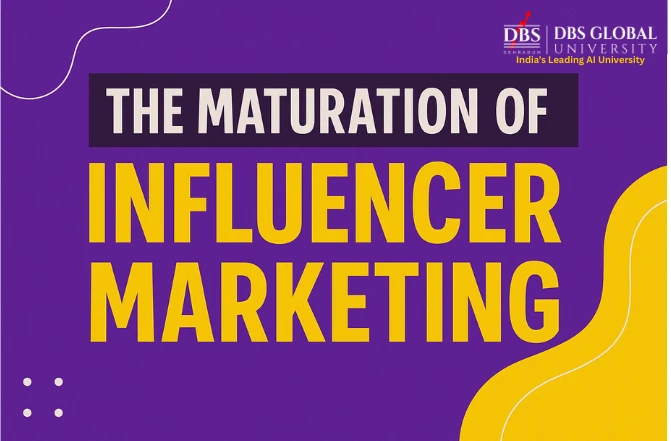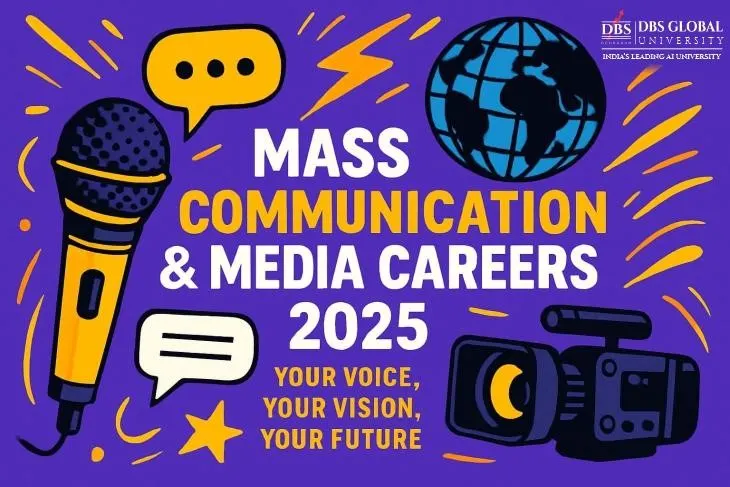
The Maturation of Influencer Marketing
admin
- 0
Influencer marketing isn’t dying. It’s just grown up
Influencer marketing used to be simple: post a pretty picture, drop a hashtag, wait for the likes to roll in. But that era? It’s over.
Today,
Influence isn’t just borrowed power; it’s calculated trust, cultural capital, and content that converts. Behind every viral collab is a strategy deck, a target persona, and a serious push for ROI. This isn’t the age of hype. This is the age of intentional influence, where creators are brands and partners, not billboards. And if you are still treating influencer marketing like a side hustle, you are already behind.
Back then, influencer marketing was all about numbers; the bigger your following, the bigger your paycheck. Brands chased follower counts like they were stock prices, handing out collaborations to anyone with a blue tick and a curated feed.
- •Strategy? Optional.
- •Authenticity? Not really the point.
The goal was visibility, to get the product in front of as many eyeballs as possible. It didn’t matter if those eyeballs actually cared. Mega influencers ruled, content was glossy, and engagement often meant a heart emoji and a “slay, queen” in the comments.
Fake followers. Bought likes. Shallow engagement.
The ROI? Questionable. The trust factor? Slipping.
The early days were glamorous, yes!
But they were built on shaky ground. And the industry was bound to wake up.
The Shift: From Likes to Loyalty
As audiences grew savvier and algorithms got smarter, the rules of the game changed. Suddenly, a million followers didn’t mean a million impressions or even a million people who cared.
Brands started asking tougher questions:
- •Are we reaching the right audience?
- •Is this content driving action, or just double-taps?
- •Do people trust this creator, or just follow them?
That’s when the spotlight moved from influencers with power to creators with connection. Enter: micro and nano influencers. Smaller followings, yes but tighter communities, higher engagement, and way more trust. They weren’t just promoting products; they were shaping opinions.
The best part? They felt real.
- •Less polished, more personal. Less scripted, more story.
- •And that authenticity started translating into actual brand love and sales.
Influence, it turned out, wasn’t about being everywhere. It was about being believable.
The Now: Signs of Maturity
Influencer marketing has officially left its teenage phase. It’s no longer a side experiment in the marketing mix; it is the mix. What used to be a brand’s optional flex is now a full-blown strategy, backed by data, research, and ROI-focused execution.
Here’s what maturity looks like:
- 1. Strategy Over Hype
- •Brands aren’t chasing virality for the sake of it. They are building influencer campaigns around business goals, be it awareness, engagement, or conversions. Influencers are being briefed like creative partners, not just digital billboards.
- 2. Long-Term Partnerships Over One-Off Posts
- •The trend is clear: brands want relationships, not one-night stands. Ongoing collaborations lead to consistency, deeper storytelling, and stronger audience trust.
- 3. Content Co-Creation is the New Norm
- •Brands are no longer dictating every caption and creative. They are inviting creators into the brainstorming room. Why? Because good content isn’t corporate, it’s creator-led, platform-native, and real.
- 4. Performance Metrics Go Beyond Likes
- •Clicks. Saves. Shares. Link-tap-throughs. Story views. Affiliate sales. The real MVPs are the backend numbers, not just visible vanity stats.
- 5. Niche Over Mass
- •Influencers with tight, specific communities (think: finance enthusiasts, skincare junkies, book reviewers, eco-minimalists) are now more valuable than generic “lifestyle” creators. Relevance wins over reach.
- 6. AI and Virtual Influencers Are Emerging
- •From AI-generated creators like Lil Miquela to CGI-enhanced content, brands are experimenting with the future of influence. It’s new. It’s bold. And it’s working.
Influencer marketing today isn’t just about attention; it is about alignment. When brands and creators truly align, audiences don’t just consume. They connect.
The Challenges: Growing Up Isn’t Glamorous
As influencer marketing levels up, it also faces a tougher crowd and tighter scrutiny. With growth comes growing pains and this industry is no exception.
- •Oversaturation Is Real
- •Everyone’s an influencer now. Every scroll, every swipe, another face promoting another product. The noise is deafening. Standing out takes more than just aesthetics; it takes purpose.
- •Trust Isn’t Guaranteed Anymore
- •Audiences have become more skeptical. They can spot a scripted #ad from a mile away. Blind promotion doesn’t cut it; authenticity and relevance matter more than ever.
- •Fatigue is Setting In
- •Sponsored content is everywhere, and users are tuning out. Even the best collaborations risk being ignored if they don’t add real value or entertainment.
- •Algorithms Keep Shifting the Goalposts
- •What worked last quarter might flop this one. Platforms constantly change their rules, affecting reach, engagement, and discoverability. Staying visible takes constant reinvention.
- •The Legal and Ethical Spotlight
- •Governments and platforms are cracking down on disclosure, transparency, and data usage. Influencers and brands alike must navigate tighter regulations and rising accountability.
- •Performance Pressure
- •As budgets get bigger, so do expectations. Brands want measurable impact. Creators are expected to deliver creativity and conversions. It’s no longer just about influence; it’s about outcomes.
Influencer marketing is still powerful, but now it has to be smart, sincere, and strategic to survive the scroll.
The Future: Conscious Influence Is the Next Big Play
The next era of influencer marketing won’t be about who’s the loudest. It’ll be about who’s the most aligned. The future belongs to creators who stand for something, and brands that treat influence as a relationship, not a rental.
Here’s where it’s headed:
- •Influencers as Entrepreneurs
- •Creators are no longer just content machines; they’re launching their own brands, products, and communities. They’re building equity, not just collecting paychecks.
Examples:
- •Kusha Kapila – UnderNeat
- •MrBeast – Feastables, MrBeast Burger
- •Lilly Singh – Unicorn Island Productions
- •Tanmay Bhat – SuperteamDAO, Honestly by Tanmay
- •Komal Pandey – Fashion edits & styling drops (self-branded)
- •Affiliate Models and Revenue Sharing
- •Traditional flat-fee deals are giving way to performance-based partnerships. Creators will earn like stakeholders, not just spokespersons, bringing accountability and upside to both sides.
- •Brands Will Build In-House Influencers
- •From employee advocacy programs to brand-owned personas, companies will start cultivating influence from within, blurring the lines between corporate and creator.
- •Cred – Rahul Subramanian & Brand Creators
Instead of relying solely on external influencers, Cred has nurtured a distinctive in-house content style, rooted in satire, pop culture, and creator-led comedy.
Comedian Rahul Subramanian became a recurring face across Cred’s campaigns, not just as talent but as part of a consistent creative voice. This blend of in-house brand strategy and recurring creator personalities has helped Cred build its own “influence ecosystem”.
- •Values-Driven Collabs
- •Audiences want more than aesthetics. They’re aligning with creators and brands that reflect their beliefs—whether it’s sustainability, inclusivity, or social justice. Cause marketing and conscious collabs will take center stage.
Example:
- •Ankush Bahuguna × L’Oréal Paris – #MenDoMakeup
Ankush Bahuguna, a creator known for normalizing beauty for men, collaborated with L’Oréal Paris to challenge gender stereotypes in makeup.
The campaign didn’t just sell products, it sparked conversations around inclusivity, self-expression, and breaking beauty norms.
- •Smarter, Smaller, Sharper
- •Micro and nano influencers will continue to thrive, not just because they’re affordable, but because they’re real. In the end, trust beats reach every time.
Influencer marketing is evolving from a game of visibility to a craft of resonance. And those who treat it with intention, creators and brands alike, won’t just trend.
They’ll lead.
FAQ: Frequently Asked Questions: The New Era of Influencer Marketing
Q1: Is influencer marketing still effective, or is it dying?
Ans. No, it is not dying. It has matured. The era of low-effort posts for high rewards is over. Today, influencer marketing is more effective than ever when it’s approached with a strategic, data-driven, and authentic mindset focused on building real trust and driving measurable results.
Q2: What is the biggest difference between influencer marketing then and now?
Ans. The biggest shift is from reach to resonance. Previously, brands prioritized follower counts and visibility. Now, the focus is on authenticity, niche relevance, high engagement, and content that drives specific actions, such as clicks and sales, not just likes.
Q3: Why are micro and nano-influencers considered more valuable now?
Ans. Micro and nano-influencers have smaller, but highly dedicated and trusting communities. Their content feels more personal and authentic, leading to significantly higher engagement rates and a greater ability to influence their audience’s purchasing decisions compared to many larger, less relatable influencers.
Q4: What metrics should brands be looking at beyond likes and followers?
Ans. Modern influencer marketing focuses on performance metrics that indicate deeper engagement and conversion. Key metrics include: click-through rates, story views, saves, shares, website traffic, affiliate link taps, and actual sales conversions.
Q5: What does the future hold for influencer marketing?
Ans. The future is conscious influence. This includes long-term brand-creator partnerships, creators launching their own entrepreneurial ventures, performance-based affiliate deals, values-driven collaborations, and the strategic use of in-house influencers and AI-powered virtual creators.
“Influencer marketing isn’t about selling a product anymore, it’s about selling belief. And belief, when earned, is an influence that lasts.


